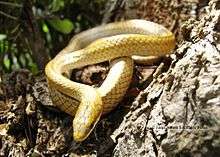Symphimus
Symphimus is a genus of snakes in the family Colubridae. The genus is endemic to Mexico and Central America.[1]
| Symphimus | |
|---|---|
 | |
| Symphimus mayae, in a tree, in Yucatán, Mexico | |
| Scientific classification | |
| Kingdom: | Animalia |
| Phylum: | Chordata |
| Class: | Reptilia |
| Order: | Squamata |
| Suborder: | Serpentes |
| Family: | Colubridae |
| Subfamily: | Colubrinae |
| Genus: | Symphimus Cope, 1869 |
Species and geographic ranges
Etymology
The specific name, mayae, is in honor of the Maya of the Yucatán Peninsula.[2]
Reproduction
Snakes of the genus Symphimus are oviparous.[1]
gollark: It plays when I die.
gollark: It is my death contingency.
gollark: Wow, 11 players.
gollark: My computer's fans are beginning to incurse.
gollark: Minecraft takes time to start up.
References
- Genus Symphimus at The Reptile Database.
- Beolens, Bo; Watkins, Michael; Grayson, Michael (2011). The Eponym Dictionary of Reptiles. Baltimore: Johns Hopkins University Press. xiii + 296 pp. ISBN 978-1-4214-0135-5. (Symphimus mayae, p. 172).
Further reading
- Boulenger GA (1896). Catalogue of the Snakes in the British Museum. Volume III., Containing the Colubridæ (Opisthoglyphæ and Proteroglyphæ) ... London: Trustees of the British Museum (Natural History). (Taylor and Francis, printers). xiv + 727 pp. + Plates I-XXV. (Genus Symphimus, p. 642).
- Cope ED (1869). "Seventh Contribution to the Herpetology of Tropical America". Proceedings of the American Philosophical Society 11: 147–192. (Symphimus, new genus, and Symphimus leucostomus, new species, p. 150).
- Gaige H (1936). "Some Reptiles and Amphibians from Yucatan and Campeche, Mexico". Carnegie Institution of Washington Publications (457): 289–304. (Eurypholis mayae, new species, p. 300).
- Heimes, Peter (2016). Snakes of Mexico: Herpetofauna Mexicana Vol. I. Frankfurt, Germany: Chimaira. 572 pp. ISBN 978-3899731002.
This article is issued from Wikipedia. The text is licensed under Creative Commons - Attribution - Sharealike. Additional terms may apply for the media files.